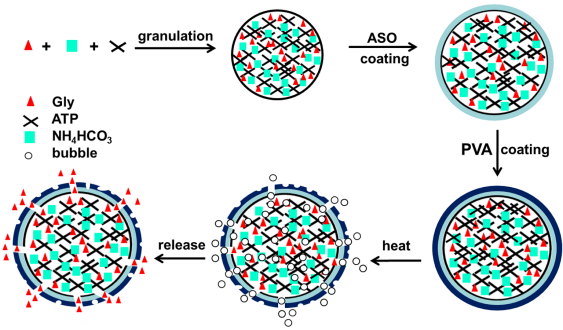
Recently, a study team led by WU Zhengyan in Institute of Technical Biology and Agriculture Engineering, Hefei Institutes of Physical Science developed a temperature-controlled-release herbicide particle (TCHP) using a nanocomposite.
Pesticides have been applied to controlling weeds, pests, and diseases all over the world as well as plays a key role in crops protection. Traditional pesticide unabsorbed by crops tends to discharge into environment through rainwater washing, leaching, and volatilization, which causes severe pollution to ecosystem and hazard to health of human beings.
Therefore, it is of great importance to develop facile approaches to reduce the loss of herbicide and enhance the utilization efficiency (UE).
To address this need, WU's team developed TCHP with a core-shell structure using a nanocomposite consisting of attapulgite(ATP), NH4HCO3, amino silicon oil (ASO), polyvinyl alcohol (PVA), and glyphosate (Gly).
In their study, the ATP-NH4HCO3-Gly mixture acts as the core, and ASO-PVA acts as the shell.
The micro/nano pore number and the solubility of the PVA shell can be efficiently controlled by temperature, making TCHP display a high temperature-controlled-release performance.
Importantly, this technology could significantly control the loss of Gly under simulated rainfall and thus enhance the control efficiency on ZM. Additionally, the TCHP was rather stable in aqueous solution owing to the protection of hydrophobic ASO.
This work was detailed in ACS Sustainable Chemistry & Engineering entitled "Fabrication of a Temperature-Controlled-Release Herbicide Using a Nanocomposite ".
This work provides a promising approach to control the release and loss of pesticide, making it applicable to enhance the UE and thus lower the environmental pollution.
This research was supported by the National Natural Science Foundation of China, the Key Program of Chinese Academy of Sciences, the Youth Innovation Promotion Association of Chinese Academy of Sciences, the Grant of the President Foundation of Hefei Institutes of Physical Science of Chinese Academy of Sciences, and the Science and Technology Service Programs of Chinese Academy of Sciences.

Schematic diagram of the mechanism of TCHP (Image by CHI Yu)

86-10-68597521 (day)
86-10-68597289 (night)

86-10-68511095 (day)
86-10-68512458 (night)

cas_en@cas.cn

52 Sanlihe Rd., Xicheng District,
Beijing, China (100864)

